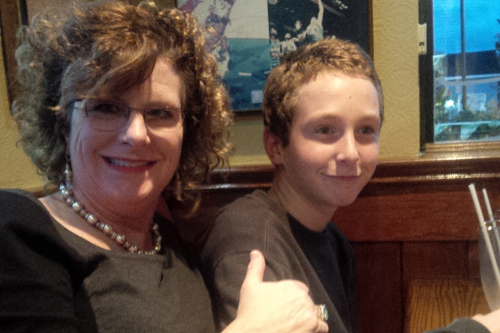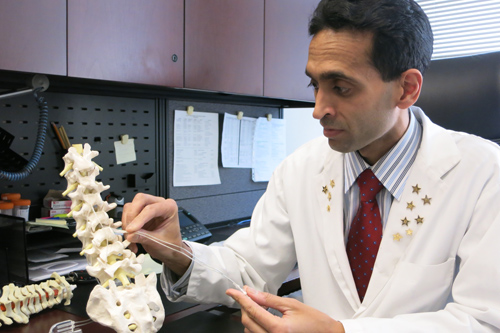
Deborah Finbow with her youngest son, Aydan, a few months before she underwent life-changing surgery to relieve her of chronic pain. Finbow had gained about 30 pounds due to lack of mobility and medication - but since surgery she has lost 15 pounds and is medication-free.(Photo: UHN)
Deborah Finbow, 52, is looking forward to buying new footwear that isn't a pair of Ugg boots. For the last two years, the boots were the only ones big enough to fit her injured foot.
The married mother of four from Collingwood, Ont., had given all of her shoes away –convinced she would never be able to wear them again.
It all began in 2011 when Finbow's hand was repeatedly bitten by a dog.
Although she was treated at the local hospital, even when the wound healed,she began to experience very painful inflammation - not in her hand, but in her left foot.
It would swell, become discoloured, and burn and tingle with incessant pain. With each bout of inflammation, the symptoms became progressively worse.
Bone infection
She was finally diagnosed with osteomyelitis, a bone infection.
By March 2012, the inflammation was so severe that Finbow underwent a surgical procedure to relieve it.
Despite the surgery, along with drugs, antibiotics and rehabilitation, the pain remained.
Doctors determined that as a result of the infection, Finbow had also suffered damage to the nerve in her foot which was causing the unbearable pain.
Pain worse than amputation
She was diagnosed with Complex Regional Pain Syndrome (CRPS).
Experts rate her pain experience of CRPS at 42 on a scale of 50 –higher than both untreated natural childbirth and amputation pain.
Finbow could no longer put any pressure on her foot and relied on a walker and cane to stand and get around – if she even had the energy to try.
She couldn't stay warm, even in summer, because her body took on the same temperature as her foot and leg: ice cold.
"It takes everything out of you," she said. "The pain and discomfort was so intense that I just wanted to stay home in bed and sleep as much as possible."
Husband becomes mom, dad
A high school administrator, Finbow had to quit her job as a result. At home, she had to give up most things, including cooking.
It was difficult, she said, watching her husband take on both parenting roles - doing all the chores but also playing with their kids.
At her lowest point, Finbow said she hoped she would soon be put out of her misery.
"My youngest son was 12 at the time," Finbow recalled. "And I just kept telling myself I needed to hang on for 10 more years, to at least see him through high school, before I could give up."
Not only did she give away her shoes, but also her bicycle since she assumed she would never be able to ride it again.
A ray of hope
Doctors didn't think there was anything more they could do for her. She was told to get a wheelchair and do her best to manage the pain.
But one physician thought it might be worthwhile to see if any specialists could help. That's when the focus turned to Toronto Western Hospital's Krembil Neuroscience Centre.
Finbow was first referred to Dr. Anuj Bhatia, an anesthesiologist and pain specialist, to determine whether other pain medications might help alleviate her CRPS.
It was the first time in a year that Finbow felt any hope her condition might improve.
Unfortunately, the medication left her feeling groggy and sluggish - and still unable to live her life.
It was time to consider a final alternative: surgery.
Neurostimulation
Finbow was referred to neurosurgeon Dr. Mohammed F. Shamji, who specializes in neuropathic pain – damage to a complex sensory system responsible for how we perceive things, such as touch and temperature.
Conditions caused by neuropathic pain often have symptoms of amplifying normal sensations to the point of persistent discomfort.
Patients often feel very hot or very cold "pins and needles" sensations, numbness, and itching - much like what Finbow was experiencing.
Shamji, who joined KNC nearly two years ago, is working to organize a program to treat patients like Finbow with neurostimulation.
Implanted device blocks pain signals
It involves a surgically implanted device, about the size of a stopwatch, in the epidural space around the spine that delivers a controlled electrical signal to the spinal cord.
The electrical impulses deliver a tingling sensation to the brain while also blocking pain signals that the patient experiences, essentially overriding the pain sensation.
Remote control adjusts intensity
The patient is taught how to operate a remote control that can change the intensity and patterns of stimulation at any time, adjusting them for different scenarios such as sleeping, walking or activity when the effect may need to be stronger.
Although the technology has existed for a few decades, it is not as well-known as a treatment option for patients with severe, chronic pain.
"Neurostimulation is certainly not for everyone. Some patients don't receive any benefit from the device and others are not comfortable with the tingling sensation it generates," Shamji said.
"However, we are working on a system to get the right patients to our program so they can be evaluated and treated quickly," he continued. "This technology is underutilized but can be extremely efficient in enhancing the quality of life of these patients."
No question
Finbow was assessed as a candidate for the procedure - in her case, called a spinal cord stimulator - but was advised that it might only lessen her pain by 50 per cent.
She decided to go ahead with the surgery.
"I was so desperate," she said. "I was willing to try anything even if it would only reduce the pain I was experiencing a little."

Dr. Mohammed Shamji demonstrates how a spinal cord stimulator alleviates pain. Implanted wires deliver a controlled electrical signal to the spinal cord, sending a tingling sensation to the brain while also blocking pain signals that the patient experiences. (Photo: UHN)
New shoes, new bike and more
The procedure more than exceeded Finbow's expectations.
Just two weeks after the surgery, with her stimulator properly programmed, Finbow no longer felt any pain.
Today, she can not only put weight on her foot, but walk around by herself. The swelling has gone down and she's not only returned to her old shoe size - she's returned to her life.
For a family who now has their mom back, it's made a world of difference.
"The joy that I felt over the result of my surgery was reflected in my son's face," Finbow said, noting that before she'd even returned from the hospital, her son had begun looking online at new bikes for her in the hopes that they could return to cycling together.
Renewed life
Now Finbow is turning her attention to the activities she thought were lost to her forever.
First on the list is a visit with her daughter who moved to Waterloo two years ago to attend law school. Finbow had been unable to make the trip before because it was too painful to sit in a car.
"This whole ordeal started the year I turned 50," she said. "Thanks to Dr. Shamji, Dr. Bhatia and their whole team, I feel like I'm restarting my 50s and resuming the life I had."
Related Links
